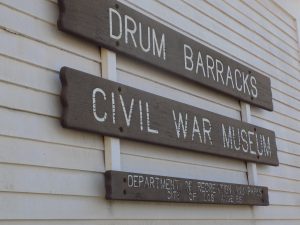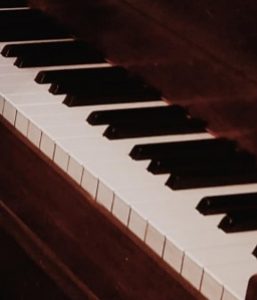Historical Pianos in Civil War California
 Last Saturday I had the privilege to continue my yearly tradition of performing Christmas carols with friends in the officers’ parlor of the Drum Barracks out here in Southern California. It’s an absolutely wonderful way to really launch into the holiday season. The high ceiling room filled with antique furniture, a Christmas tree decorated in 1860’s style, hanging holly and mistletoe evokes memories of Civil War Christmases that might have happened within those very walls.
Last Saturday I had the privilege to continue my yearly tradition of performing Christmas carols with friends in the officers’ parlor of the Drum Barracks out here in Southern California. It’s an absolutely wonderful way to really launch into the holiday season. The high ceiling room filled with antique furniture, a Christmas tree decorated in 1860’s style, hanging holly and mistletoe evokes memories of Civil War Christmases that might have happened within those very walls.
The museum structure of the Drum Barracks and a privately owned, though historically protected, gunpowder arsenal are all that remain of Camp Drum which was built in 1862 to bring a strong Federal presence to the Los Angeles area. There were simply too many Confederate sympathizers in Southern California and the overland trails needed guarded so several influential men donated land near Port of Los Angeles (now Wilmington/San Pedro area) for a large military training camp which operated between 1862 and 1865.
The building, now preserved and set-up as a museum, was originally used as quarters for officers. If the officer had a family, he, his wife, and children would have lived in one half of the building, or unmarried officers might set up bachelor quarters together in one of the building halves. In the museum’s parlor – displayed for an evening’s entertainment of bachelor’s card games – an original Steinway piano stands against the wall. We’re not exactly sure if anyone had a piano at the barracks during the Civil War years, but music was a very popular pastime and details about the current artifact piano and California stories hint that pianos were definitely at U.S. military establishments in the west during the 1850’s and 1860’s.
The Steinway currently housed at the Drum Barracks dates back to 1869 and would have come to California around Cape Horn and was even designed to travel. Sometimes called a box piano, the instrument’s legs could be taken off and the strings, hammers, and keys would be safely sheltered in the protective box of the instrument. Upon arriving at its destination, the piano would “get its legs again” and only need a little tuning before it was ready to play. Its compact, rectangular shape made it much easier to ship than the traditional shape of a piano or keyboard instrument (think concert grand piano).
 Happily, this 1869 Steinway was carefully restored in 2001 and can be played on special occasions. Some notes are a little out of tune, but that only adds to the charm of hearing (or playing) this historic instrument.
Happily, this 1869 Steinway was carefully restored in 2001 and can be played on special occasions. Some notes are a little out of tune, but that only adds to the charm of hearing (or playing) this historic instrument.
As I took a turn at the keyboard, I started thinking about historical accounts or stories of pianos during the Civil War. There’s my all-time favorite of a Confederate soldier convincing some pro-Union girls in Gettysburg to play for him and trying to teach them Southern songs…which lyrics the girls quickly rewrote reflect Union sentiments. There’s the Hollywood popularized account of Kathleen Mauvorneen which was played by Mrs. Albert S. Johnston at the officers’ farewell gathering in California in the early spring of 1861. “Stonewall” Jackson patiently trying to appreciate music. J.E.B. Stuart gathering everyone around the piano for a time of singing and merriment.
Then I remembered the stories that Mrs. Winfield S. Hancock recorded in her reminiscences of military post life in the west, in California. Almira Hancock never lived at Drum Barracks and had left California by the time this structure had been built, but she had lived in Los Angeles – that little pueblo town. Captain Hancock had been the quartermaster and a worried man about the pro-Southern sympathies in SoCal during 1860 and 1861. In fact, his attempts for defense and urgent messages had brought the Federal troops from Fort Tejon to Los Angeles and started the groundwork for establishing Camp Drum.

However, Mrs. Hancock’s story about piano playing in California took place prior to that happening. It’s an account that hints at the roughness of the state and town and her attempts to make her Los Angeles cottage (mud-adobe building) a civilized home and headquarters.
After peace had been established [with the Mojave Tribes], as a matter of policy the chiefs and other prominent Indians were invited to visit the Quartermaster in Lose Angeles, as they had already been much impressed with the grandeur of his formidable train of wagons. On arrival they were formally escorted to the residence of the big chief. When passing the large market building, which had just been completed, they turned to go in, thinking it was in keeping with his great wealth, etc. Their disappointment was evident when they reached the modest little cottage, minus one gable-end, a result of the heavy rains. They gave three audible grunts and shook their heads dubiously, that so great a man should live in so humble a manner. As soon, however, as they were taken to their tents, pitched in the corral, within a short distance of the house and there viewed the great possessions of the Quartermaster’s Department, their increased respect was apparent. Jack, a bright young Indian, who spoke a little English, and who was the heir-apparent of the Mojave chieftainship, exclaimed, “Much mulie and wagon, much pork and beanie, house no goodie,” pointing toward the Captain’s home, with evident discontent.
In music they evinced much interest, and, if possible, would keep me at the piano, or “music table,” so called by them, from early dawn until night. Upon one occasion, when I was entertaining these dusky friends with “The Girl I Left Behind Me,” and other airs with which they were familiar, from having heard them played by drummers and fifers, at Fort Mojave, I was nearly overcome, upon completing the performance, to find half of the Indians in as complete deshabille as possible to conceive, some making strenuous efforts to force their legs into the sleeves of some gaudy shirts that had been presented to them, others trying on hats, and making their toilet in numerous ways. It was time for me to make an exit, as they were having altogether too good a time at our expense. [1]
My favorite part of her account is the reminder that music can be a universal language. Unable to communicate with the visiting Native Americans but wishing to be a good hostess, Mrs. Hancock played music for them. Her guests loved it, always requested more entertainment, and at one point had a jolly mishap while trying to dress in new clothing.
 This year at the Drum Barracks we were able to share Christmas carols and traditional Civil War music in a similar spirit of sharing and goodwill. Perhaps we couldn’t always speak the languages of our guests, but we could smile and sing and watch them cherish that moment of historic sounds for the holiday season. Some guests came and sang with us, participating in the experience of creating parlor music that adds joy to a chilly day, song to a silent, old building, and hope for days of peace.
This year at the Drum Barracks we were able to share Christmas carols and traditional Civil War music in a similar spirit of sharing and goodwill. Perhaps we couldn’t always speak the languages of our guests, but we could smile and sing and watch them cherish that moment of historic sounds for the holiday season. Some guests came and sang with us, participating in the experience of creating parlor music that adds joy to a chilly day, song to a silent, old building, and hope for days of peace.
As we folded our music books to finish the day at the barracks, one of the girls insisted that we gather round the piano for one more song. “Auld Lang Syne,” she requested. We sang the familiar words while the notes echoed from the old piano. Fittingly, the breeze gently blew the parlor door closed as we sang the final chorus. There was a warmth in the scene, joy and memory in the words, and music in the parlor one more time.
Sources:
- Reminiscences of Winfield Scott Hancock by Almira Russell Hancock, pages 60-62.
how lovingly you write of the era … and gently remind us of the piano’s beauty and calling. – tsk
Sarah is the future, we hope, of independent historians. When severalo f us in California meet up at conferences r events, we have such a great time–tea & coffee are drunk and tears are shed. I always wonder if those men & women would be surprised that, so long after their deaths, they are still mourned?
I believe they would be. They were simply living. So I think the best way to honor them is to keep them living … which is the beautiful work you’re doing. – tsk